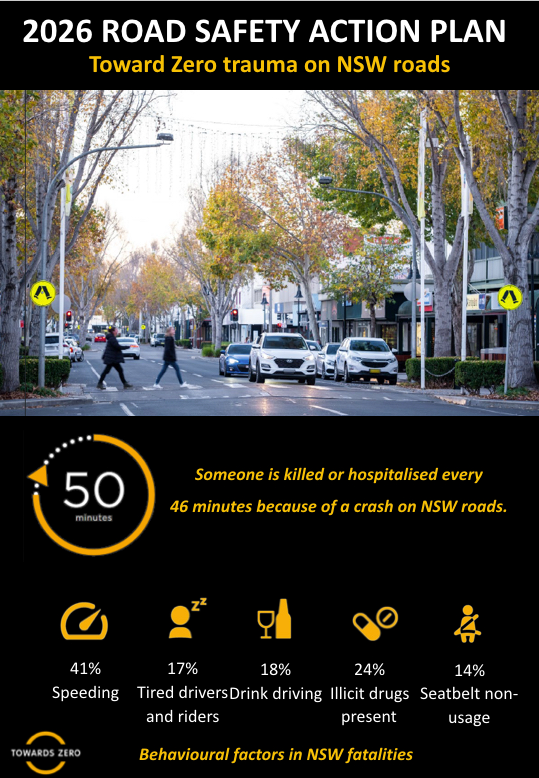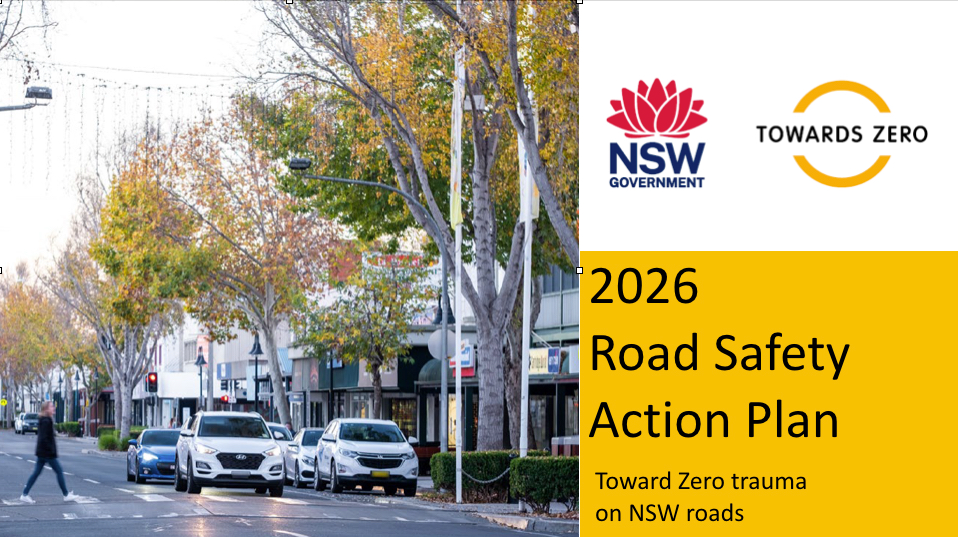By Transport NSW
The NSW Road toll isn’t simply a number. It is people. It’s people like you. Grandparents, mothers, fathers, children. And it’s a number that’s unacceptable, no matter how small it gets, until it gets to zero.
That should be the aim for all of us – government, law enforcement, businesses, communities, families, and individuals – we should work together to do everything in our power to reduce the number of deaths on NSW roads towards zero.
Last year NSW released its 2026 Road Safety Action Plan, a key element of the state’s commitment to achieving zero deaths and serious injuries on NSW roads by 2050. The 2026 Road Safety Action Plan seeks to build on the success of the Road Safety Plan 2021 with new road trauma reduction targets for 2030, setting NSW on a path towards zero road trauma by 2050.
Someone is killed or hospitalised every 46 minutes because of a crash on NSW roads.
As pedestrians and drivers, seniors are especially vulnerable to road accidents.
In the Sydney metropolitan area, people over 60 years of age accounted for 28% of all pedestrian casualties and 62% of all pedestrians killed in 2019.
In 2019 in the Sydney Metropolitan area, drivers aged 60 years and older: represented 18.8 % of all drivers killed. represented 13.8 % of all drivers injured.
The safety of vulnerable and other at-risk road users, such as seniors from CALD backgrounds should be one of the priority areas to address road safety in NSW.
ECCNSW’s Community Road Safety Project funded by Transport NSW aims to target seniors from culturally and linguistically diverse backgrounds.
The 2026 Road Safety Action Plan features new targets to halve deaths and reduce serious injuries by 30% on NSW roads by 2030. This will be achieved by building on the success of the Road Safety Plan 2021 and will focus on stronger local government action, engagement, and education programs and using technology in the fight to end road trauma.
By 2050, NSW has set an aspirational target of zero fatalities and serious injuries on our roads.
How do we respond to the challenge and community findings?
The 2026 Road Safety Action Plan continues to adopt the internationally recognised Safe Systems approach, which is a holistic and proven approach that considers how people, vehicles, speeds, and roads work together to create a safe system.
Safe people: People are at the heart of the safe system approach to road safety. All road users owe it to themselves and to everyone else on the road to follow the road rules and drive to the conditions. Crashes can be prevented, and lives can be saved, by making safe choices.
If you’re tired, distracted, speeding or impaired by alcohol or drugs, you cannot react as quickly to unexpected changes on the road. In the event of a crash, your choice of speed or decision to wear a seatbelt can make the difference between life and death for yourself, your family, or friends – as well as others involved.
Safe road: Safe roads are designed and built to be more forgiving and account for human error.
If a driver or rider makes a mistake, road infrastructure can significantly reduce the chance that it will result in a fatality or serious injury.
To do this, we:
- Upgrade roads and improve road design; install new road signs, surfaces, markings and safety barriers; and remove roadside hazards.
- Assess long stretches of major roads as part of route safety reviews to identify road improvements and couple them with enforcement and education programs.
- Separate road users as much as possible with median separation treatments such as wide centreline and median safety barriers.
Safe Speeds: A small increase in speed can make a big difference to the seriousness of a crash.
Speeding includes travelling above the speed limit as well as driving too fast for certain conditions. As well as being identified as a contributing factor in around 40 percent of fatal crashes each year in NSW, speed can worsen the severity of all crashes.
In a crash, the human body can only tolerate a certain level of physical force before death or serious injury is inevitable.
This is especially true for vulnerable road users such as pedestrians, motorcyclists and riders, children, and older people. That’s why setting safe speed limits, as well as ensuring drivers comply with these, is critical.
Speed limits are set so vehicles travelling at the speed limit are able to safely respond to potential risks in the road environment. Lower speed limits, for example, are used in more built-up areas where there are more people and vehicles around, to reduce the chance of crashes and people being seriously injured.
Safe Vehicle: This crash at 60km/h shows why you should always choose the safest used car you can afford. But remember, your speed ultimately determines what happens if you hit another person or vehicle. The faster you go, the greater the injuries.
https://fb.watch/kgJoUgVD2T/
When it comes to safety, not all cars are equal. Some safety features like front airbags come standard in most new vehicles, but other technologies don’t. Important safety features to look out for in both new and used cars include:
- Electronic Stability Control (ESC)
- Lane Departure Warning
- Side Curtain Airbags
- Autonomous Emergency Braking
It is important to inform the communities that great gains have been made in changing Australia’s road safety culture while educating them about road safety so that they continue to be reminded of themselves and share the message with others.
It is believed that raising awareness of these successes will encourage an appreciation of how effective countermeasures for enhancing road safety have been and can contribute to the development of a culture that is receptive to new initiatives aimed at preventing harm and saving lives.
It will also address the main obstacles to bringing about further positive changes in CALD community attitudes and behaviours, particularly in relation to actions that the community may not necessarily view as risky, such as jaywalking and using a phone while driving or cross walking.
Road Safety is EVERYONE’s responsibility. Drivers, riders, and all road users.
Achieving our goal of zero trauma on NSW roads will require all of us to work together.

What road safety results will the ECC NSW’s Community Road Safety project bring for the CALD communities?
- This project aims to provide engagement, educational sessions, and awareness campaigns that align with the 2026 Road Safety Action Plan in 8 community languages to approximately 600+ seniors from various culturally and linguistically diverse backgrounds.
- In-language educational resources and information delivered by the team of experienced bilingual educators at the ECC NSW will help increase road safety awareness in CALD senior pedestrians and CALD senior drivers.
- Road safety awareness for CALD senior pedestrians and CALD senior drivers will be strengthened through the following project activities:
-
- Over 600 CALD seniors 55+ from various existing programs that the ECC NSW is currently facilitating will be engaged and will receive in-language educational sessions about road safety.
-
- More awareness campaigns will be delivered through various ethnic media channels to promote the NSW 2026 Road Safety Action Plan. It is anticipated that a broad campaign through ethnic CALD media channels including SBS language radio, community ethnic radio, ethnic community newspapers & and magazines, and other social media platforms will increase road safety awareness in CALD communities exponentially. As a result of the in -in-language information sessions, and the targeted media campaigns, CALD seniors and their families and friends, and broader community members will have an increased awareness and knowledge of road safety, becoming safer road users.
- It is envisaged that this project will help reduce the number of incidents, injuries, and fatalities on our roads and side/crosswalks.

